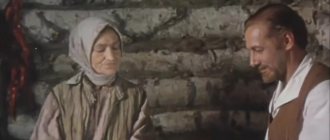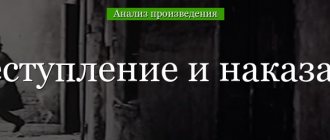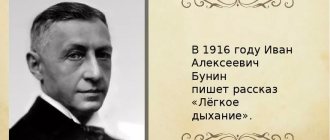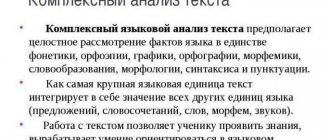Genre, direction
Bunin's works take pride of place among the best Russian prose. Being a fan of realism, the author depicts real life and real people in his stories and characters as accurately as possible. He describes amazingly accurately and carefully the parts of life that help convey the writer’s message to readers as best as possible. “Beauty” is a short story; its events describe the life together of three heroes. The story has three plot lines.
- The first line depicts the husband's relationship with his new wife. The marriage of this unremarkable man with the “beauty” caused sincere surprise of the people around them. The family structure is also presented. It turned out that the head of the family is afraid of his wife, gives the reins of the household into the hands of his wife, and “forgets” about his own son in order to please the woman who does not care about her stepson.
- The second line introduces readers to the wife and the orders that she established in the house. She takes great care of the furniture, as well as the things of the previous owner, while she treats living people - her husband and stepson - with indifference and without interest.
- The third line tells about the life of the protagonist’s son from his first marriage, who, having lost his mother, finally lost the attention and warm attitude of his loved ones. He has to sleep on the floor because his stepmother forced him to move off the couch, read his only book repeatedly, and live a quiet, monotonous life.
Essay for grade 11 based on the story Beauty
Ivan Alekseevich Bunin wrote the story when he was 70 years old. At this age, you rethink your life and see through people. To understand a person, you can simply look at his attitude towards others. The author touches on more than simple relationships in the family. The work describes three storylines: the relationship of a father with his second wife, the mistress of the house and a seven-year-old boy. There are no names in the story; the writer generalizes the category of a certain circle of people.
The story begins with a description of an elderly man who was widowed and remarried. The old man was an official, he looked very bad, but he married a young, confident woman. This sharp contrast, just by the appearance of the characters, makes it clear that people are different.
With the advent of a new mistress in the house, life became joyless and quiet. The woman reigned, which means no one could object to her. She quietly hated the boy. What does this oxymoron mean? Manifestation of indifference, withdrawal from family, life without love and affection. All this fosters unsociability, tightness, and insincerity in the child. He is simply afraid to live.
The boy became as if he did not exist in the house. This reinforces the understanding that a son means nothing to his father. He lives in a house, but the place allocated to him is emphasized with diminutive suffixes: kindness, sofa, bed. He keeps an eye on everything despite his young age.
How does a rejected child feel? Left completely alone, what will the boy know about the world? Will he be cruel or will he still know the value of his words and actions? Will the boy trust the world when he grows up? The plot has no resolution. All that remains is to figure out what will happen to him.
It is not only the new wife who shows indifference to the child in the house, but also the boy’s own father, to please his young wife. The official was such an uninteresting person that he could not even express his point of view. In addition, he wore iodine-colored glasses, which reflects his unwillingness to see reality. Unfortunately, the father, in the interests of personal happiness, forgets about his son.
Bunin's short story represents the tragedy of a child's life, the lack of parental care. Ivan Alekseevich subtly outlined the boy’s harsh life. The behavior of the child’s parents forces people to be judged not only by their appearance and position in society, but also by their moral principles.
Can a person be considered beautiful just by his appearance? Absolutely no! The author proved this. External beauty is cold, not alive. Only internal harmony makes a person complete, deserving of respect and setting an example to follow. Only positive actions will make a person beautiful and pleasant.
Grade 11
Other works: ← Analysis of Bunin's story Figures↑ BuninAnalysis of Bunin's story The Gentleman from San Francisco →
Characteristics
Official. An elderly man working in a government agency is an ordinary person. The description does not inspire sympathy for the character. The relationship with the wife, namely the fear of her, is presented in one phrase, from which it becomes obvious that the same thing happened with the late wife. This explains the reasons why women married - they had unlimited hegemony in the home. Gorgeous. An official's wife. Having become a full-fledged housewife, she began to do as she wanted with all the things in the house, and in addition, the life of her stepson. Her conversations often include direct orders; she is used to managing people and thinking about her own benefit. The son of an official. Having lost his mother, the boy's life changed dramatically, and for the worse. He became an empty space in the house. His whole life is a small space in the hallway, a few personal belongings, and endless loneliness during identical days, following each other.
Subject
The story touches on the problem of happiness in the family and the relationships between its members. In “Beauty” the view of family is completely opposite, in contrast to real life, where relatives are a support and will support a person in all troubles. There is simply no love, which is the strong foundation of the family, between the main characters. Unhealthy relationships harm everyone in the family. The way out of this situation is to be able to feel each other as close people, as one whole. The author contrasts beautiful appearances, which can be deceptive, with inner corruption. With this technique, the writer is trying to explain to readers that appearances are often deceiving.
Analysis of the work
In general, the writer resorts to a rather interesting, intriguing technique in its own way: he describes three plot lines in the story.
The first is the relationship between the father-official and both of his wives. The second is the attitude of that same beauty towards her monastery, family and relatives. The third is the attitude of the boy, who is the main character in this story. Separately, you should pay attention to the beauty herself, her attitude towards life, home and child. The writer himself says about her that she “reigned”, “had a keen gaze”, “her father pretended to be out of fear of her.” All this directly indicates to the reader the power of a person, his thoughts, judgments regarding all other people. She literally puts herself above everyone around her, she is the head of the family, at least she thinks so herself. Nevertheless, throughout the entire work, only one single phrase comes out of her mouth, which is reinforced by the words “I ordered.” As you might guess, she really considers herself in charge. And there is evidence of this. This woman changes life in the house at her own discretion, as she thinks is best, for herself. All changes in the house are a kind of core of the work. A hint for the reader himself that not all external beauty that you can see with your own eyes is internal. Often appearance and essence differ and there is no connection between them.
The boy, in turn, is literally doomed to a worthless existence. He simply begins to be afraid to live, he develops a fear of everything, although he himself is “naturally affectionate and lively.” In addition, the writer himself emphasizes his empty existence, endowing him with the epithet “non-existent”. In the story, for the father’s wife, he does not matter at all, she simply does not notice him, and the father himself, becoming like his wife, giving all of himself only to her, moves away from the child. Despite the opinion of all his loved ones, their attitude, he still exists, lives, lives his life next to them, but his existence remains worthless.
The author tries to emphasize the insignificance of the child by using words in combination with diminutive suffixes, such as “sofa”, “little book”, “corner” and others. The writer does not describe further events, but makes it clear to the reader that throughout his life the boy will remain abandoned, forgotten and simply useless to anyone.
“Beauty” is a small work filled with tragedy and great meaning. This is a small masterpiece with a deep, but at the same time such a simple and understandable idea, the essence of which can be grasped by absolutely every reader. The story of a seven-year-old boy who was hated by his beautiful stepmother can truly touch the soul. As a result of such an attitude, the child simply has to hide in a corner, becoming invisible to everyone.
Bunin managed to put the idea that not all beauty can be good into just five small paragraphs, with three main characters and a deep tragedy inside. It is quite simple to understand everything said here, but accepting it all is not as easy as it might seem. Nevertheless, the writer, revealing the essence of his work, reveals the essence of many people.
Problems
The problems of the story are predetermined by the theme of family relationships.
- Loneliness. Is the most pressing issue raised. This is shown in the life of a boy living an “independent life, isolated from the rest of the house,” left alone with himself and his stepmother and father.
- Indifference. The indifference of adults to a child causes a feeling of loneliness in the latter. This attitude is not caused by the anger of adults or the boy’s behavior. Forgetting about the child, they brought difficult trials and experiences into his life. Such an attitude towards loved ones, especially children, can easily ruin their future destiny.
- Fear. The weakness and cowardice of the protagonist in the relationship of the protagonist is unforgivable, since he forced his young son to undergo serious trials. Without being a hostage to circumstances, he could give his son the opportunity to live a happier childhood.
main idea
Arguing about the essence of man, Bunin comes to the main idea of the story - the discrepancy between appearance and internal content. According to the author, it turns out that for happiness in marriage and family life, you need not only external beauty, but also love and affection for loved ones. Without all this, the child is likely to have a difficult life. He will either become a withdrawn, intimidated person, or he will become like his father. Using the example of the main character, the author showed that people make the same mistakes without learning from previous cases. By choosing his wife with his eyes and not with his heart, the man replaced real values with erroneous ones, thereby dooming the new family to a lack of kindness, sincerity, and love in the relationship
About inner and outer beauty (based on the text by I. Bunin “Beauty”)
Is an outwardly beautiful person always a model of virtue? This question worries I. Bunin, and he tries to find an answer to it in the story “Beauty”.
The heroes of the story are an elderly official of the state chamber and his young wife. The official himself was “silent and modest,” but the girl “knew her worth.” She was “small, perfectly and strongly built, always well dressed, very attentive and thrifty.” The author calls the heroine a beauty, focusing on the discrepancy between her external attractiveness and her behavior. She “quietly hated” the official’s little son from his first marriage and ordered him to make a bed on the floor. The boy began to live a “completely independent” life. From these words it is clear: no matter how external beauty an official’s wife may have, this does not mean that she is good at heart.
The author's position is extremely clear: a person who is nice at first glance may actually turn out to be cruel and callous.
I agree with the author's position. Indeed, external attractiveness implies the presence of internal advantages. But this is not always the case. Let us remember Helen Kuragina from L. Tolstoy’s novel “War and Peace”. Everything about her is perfect: her face, her figure, and her manners. But its internal content is far from ideal.
Thus, we can conclude: someone who is good in appearance is not always an example of inner beauty. And what a pity that in our time, the outer shell of a person is more valued: a suit, a car, a position, and not his dignity: honesty, nobility, kindness.








